Waste Emission Calculators
This tab will walk you through the step by step processes of computing the emissions for your company's waste.
Using the Waste Emission Calculator
Our platform makes it easy to upload and calculate emissions associated with Waste.
There are several ways to calculate Waste Emissions, for there are several versions of waste. You can choose which type of waste you are trying to calculate for; Construction, Metal, Plastic, Paper, Electrical Items, Refuse, or Other. Each type of waste will have its own guide below in detail.
(Scope 3)
Select "Emissions"→ Select “Other” → Select “Add Record” → Select “Type” → Select either "
"Waste"
You will be prompted to fill out different data depending on which of these you select.
The data needed for "Waste" can be found below;
There are several ways to calculate Waste Emissions, for there are several versions of waste.
You can choose which type of waste you are trying to calculate for;
Construction, Metal, Plastic, Paper, Electrical Items, Refuse, or Other.
Each type of waste will have its own guide below in detail.
Click on the “Add Record” button in the top-right corner. You’ll be presented with a form to input all relevant details:
Scope Waste falls under Scope 3.
Time Frame: Choose the relevant year or custom period.
Renewable: Tick this if renewable energy is involved (not usually relevant for travel).
Office(s): Choose the office location this travel is attributed to.
Supplier, Project, Green Loan: Optional fields for traceability and categorisation.
Emission: You can either input known values or have the system calculate emissions for you
a) Construction Waste
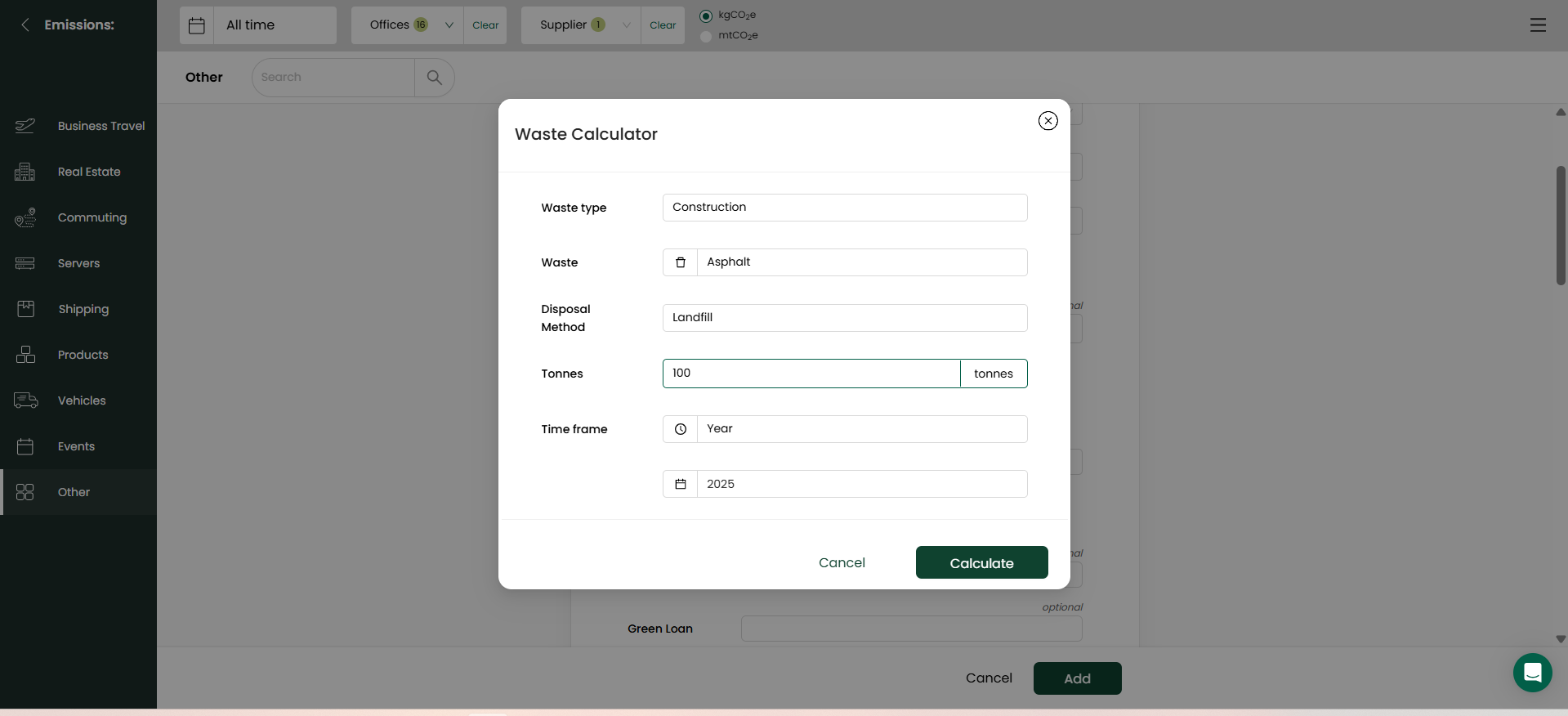
All of the necessary information to calculate waste emissions can be found below;
-
Waste Type : You can choose which type of waste you are trying to calculate for. You are able to choose among the following options; Aggregates, Asbestos, Asphalt, Average Construction, Bricks, Concrete, Insulation, or Metals.
-
Disposal Method; There are three choices when it comes to your disposal method. First is a Closed Loop ( the process by which a product is used, recycled, and then made into a new product), then a Land Fill ( a means to dispose of trash away from population centre's and safely in the ground ), or finally an Open Loop ( a recycling process that postpones disposal through converting manufactured goods into both new raw materials and waste products).
-
Tonnage of Waste : You must know how much waste you are going to be recording, in tonnes.
-
Time Frame : Finally, you must have the time frame which the waste was being removed.
Now coordinate which office it is representative of and provide a title, and if necessary you can produce a description for the activity to include further detail.
b) Refuse Waste
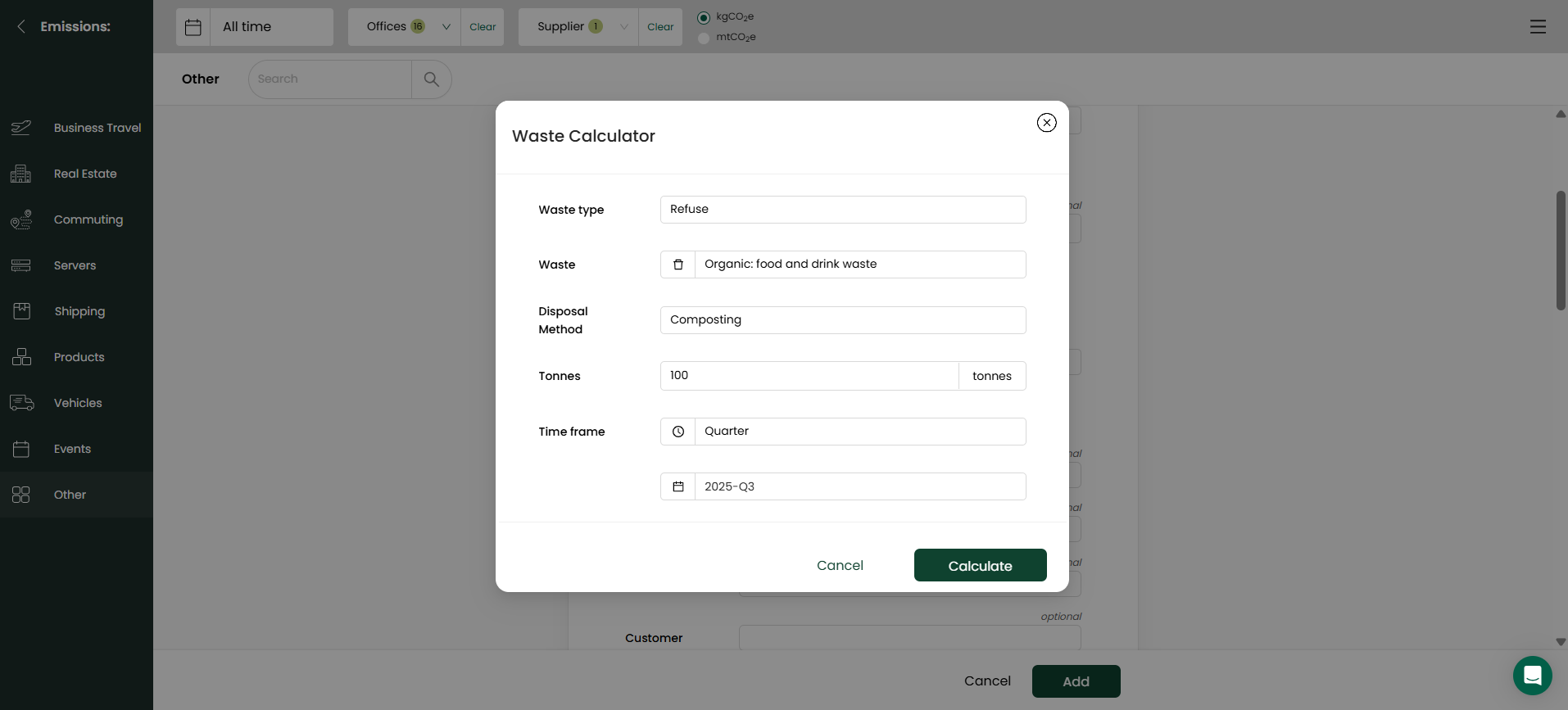
Essential Information to calculate Refuse Emissions;
-
Refuse Type : This can be categorized as any of the following; Commercial and Industrial Waste, Household Residual Waste, Organic : Food and Drink Waste, Organic: Garden Waste, or finally Organic: Mixed Food and Garden Waste.
-
Disposal Method : You can choose from a variety of disposal methods, such as; Anaerobic Digestion (sequence of processes by which microorganisms break down biodegradable material in the absence of oxygen. ), Combustion, Composting, or by Landfill.
-
Tonnage of Waste : You must know how much waste you are going to be recording, in tonnes.
-
Time Frame : Finally, you must have the time frame which the waste was being removed.
Now coordinate which office it is representative of and provide a title, and if necessary you can produce a description for the activity to include further detail.
c) Electrical Waste
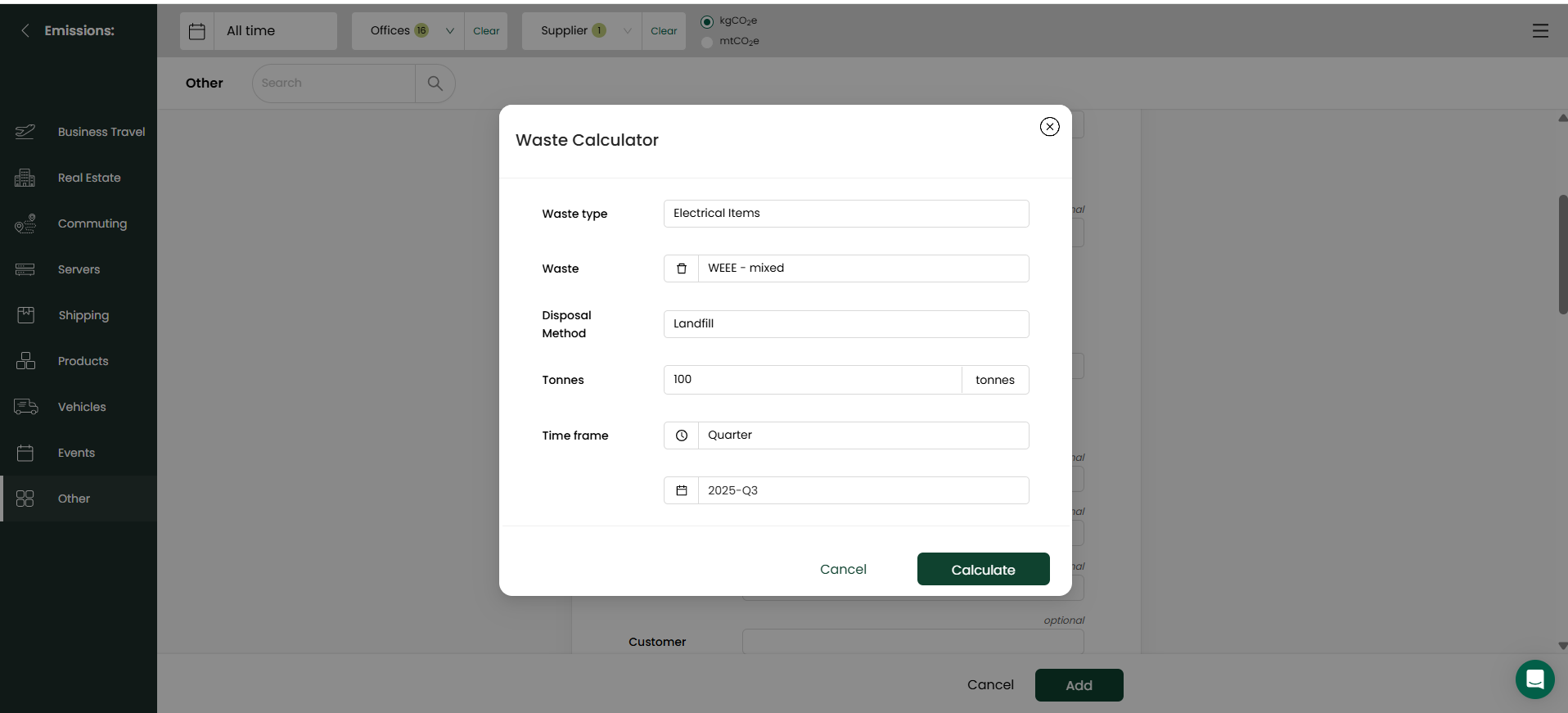
Necessary information to calculate the emissions of electrical waste;
-
Electrical Waste Types; Electrical waste can be classified into several categories such as; Batteries, Waste from Electrical and Electronic Equipment ( WEEE ) Sm, Lg, or Mixed, or WEEE ( Fridges and Freezers ).
-
Disposal Type : Electrical Items can only be disposed of in two ways, either Open Loop or via Landfill.
-
Tonnage of Waste : You must know how much waste you are going to be recording, in tonnes.
-
Time Frame : Finally, you must have the time frame which the waste was being removed.
Now coordinate which office it is representative of and provide a title, and if necessary you can produce a description for the activity to include further detail.
d) Metal Waste

Required information to calculate Metal Waste Emissions;
-
Metal Waste Types; Aluminum Cans and or Foil, Mixed Cans, Scrap Metal, and Steel Cans are the classifications of metal waste types for this calculator.
-
Disposal Methods; The methods of disposal can vary, from Open or Closed Loop, to a Landfill, or Combustion. One of these needs to be specified to accurately generate the calculation.
-
Tonnage of Waste : You must know how much waste you are going to be recording, in tonnes.
-
Time Frame : Finally, you must have the time frame which the waste was being removed.
Now coordinate which office it is representative of and provide a title, and if necessary you can produce a description for the activity to include further detail.
e) Plastic Waste
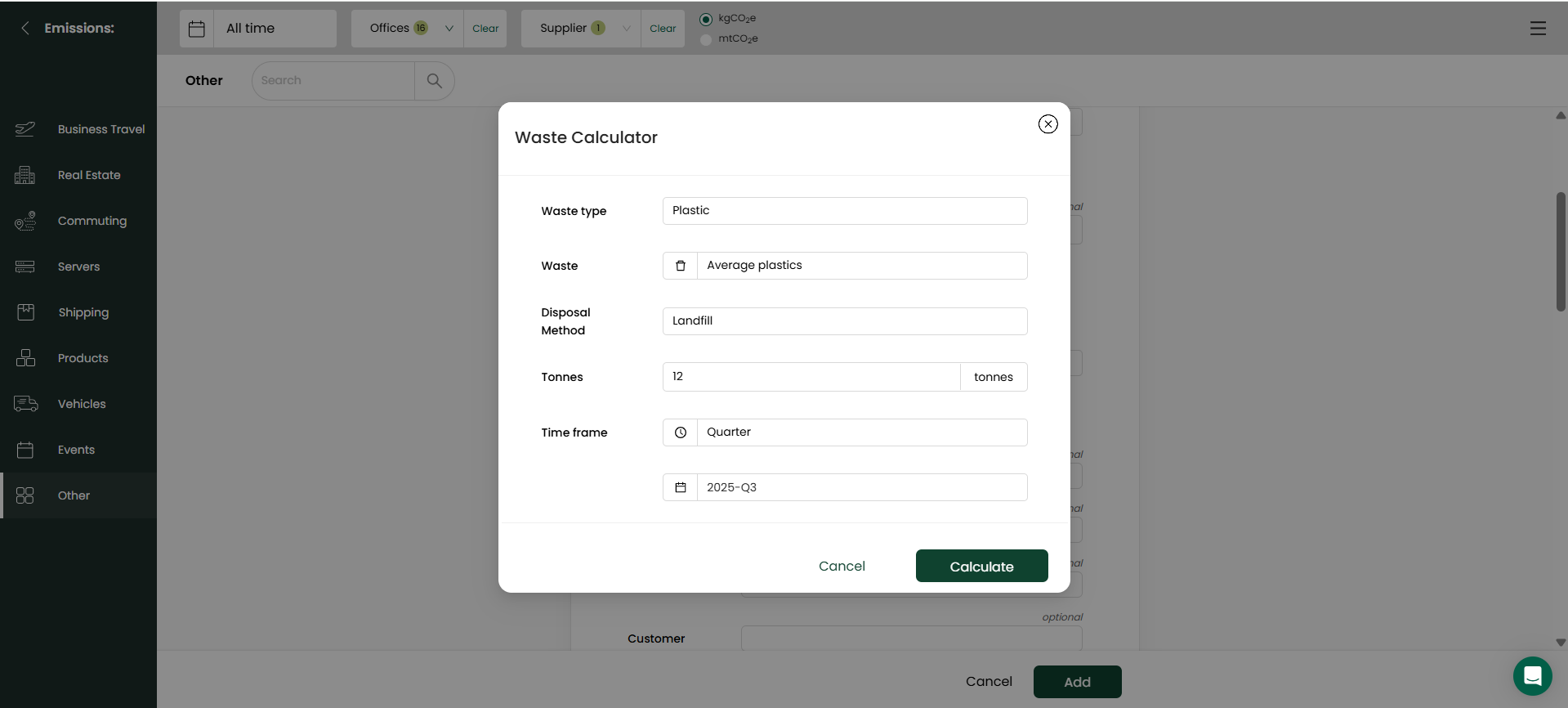
It is necessary to know these important pieces of data to accurately generate an emission calculation;
-
Plastic Waste Types : Average Plastic Film, Avg. Plastic Rigid, Avg. Plastics, High Density Polyethylene (HDPE) Plastic, Low Density Polyethylene (LDPE) and Linear Low Density Polyethylene (LLDPE), Polyethylene terephthalate (PET), Polypropene (PP), and Polystyrene (PS) plastics are all variants.
-
Disposal Methods; The methods of disposal can vary, from Open or Closed Loop, to a Landfill, or Combustion. One of these needs to be specified to accurately generate the calculation.
-
Tonnage of Waste : You must know how much waste you are going to be recording, in tonnes.
-
Time Frame : Finally, you must have the time frame which the waste was being removed.
Now coordinate which office it is representative of and provide a title, and if necessary you can produce a description for the activity to include further detail.
f) Paper Waste

You must know these specific pieces of data to compute the emissions for Paper Waste;
-
Type of Paper Waste; This can be either Paper, Board, or Mixed.
-
Disposal Methods : You can choose from either a Closed-Loop, Combustion, Composting, or Landfill for disposal options.
-
Tonnage of Waste : You must know how much waste you are going to be recording, in tonnes.
-
Time Frame : Finally, you must have the time frame which the waste was being removed.
Now coordinate which office it is representative of and provide a title, and if necessary you can produce a description for the activity to include further detail.
g) Other Waste ( Books, Clothing, and Glass)
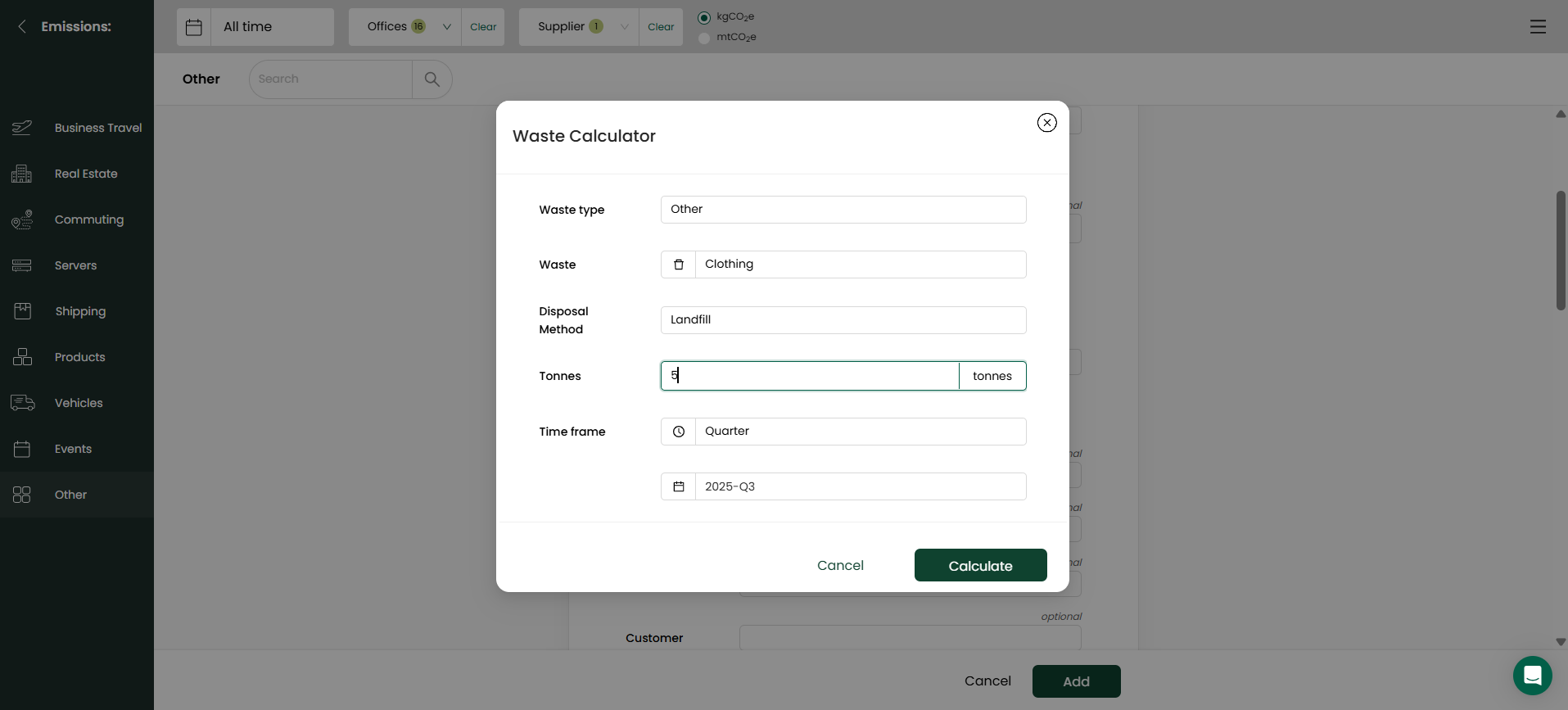
Other Waste can be broken up into three categories; Books, Clothing, and Glass.
The required information to calculate the emissions is as follows for all three types;
-
Waste Type ; Books, Glass, or Clothing.
-
Disposal Methods : Closed Loop, Combustion, or Landfill apply to all three of these, while Glass has the opportunity to be put through an Open Loop disposal system.
-
Tonnage of Waste : You must know how much waste you are going to be recording, in tonnes.
-
Time Frame : Finally, you must have the time frame which the waste was being removed.
Now coordinate which office it is representative of and provide a title, and if necessary you can produce a description for the activity to include further detail.
Once the emission value is populated (either manually or via calculation), complete any additional fields such as:
Title (e.g., “Waste Clothes Q2 2025”)
Documentation: Attach receipts, invoices, or any backup material.
Description & Calculation Description: Provide any notes or method details.
Click “Add” to save the record

Updated about 2 months ago